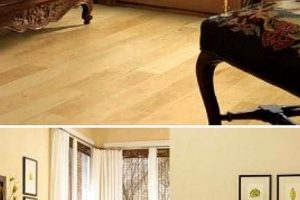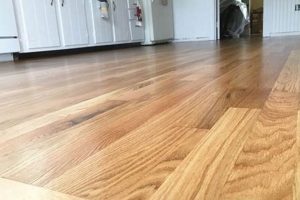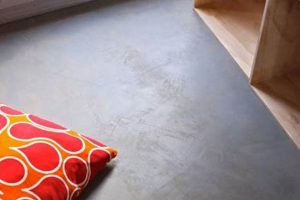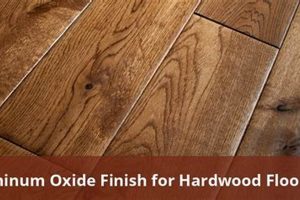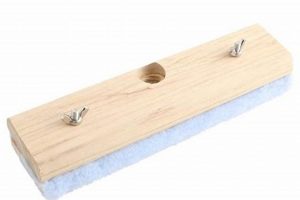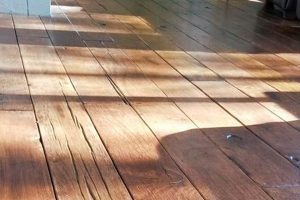The selection of a topcoat for wood flooring significantly impacts the final appearance and performance of the surface. Two common options present distinct visual and functional characteristics. One option provides a low-luster sheen, diffusing light and minimizing the appearance of imperfections. The other reflects light more directly, resulting in a shiny, high-impact aesthetic. These two categories represent different ends of the spectrum regarding reflectivity and maintenance considerations.
The choice between these two options depends largely on desired aesthetics, lifestyle, and the degree of maintenance an owner is willing to undertake. A lower-sheen finish is often preferred for its ability to conceal dust, scratches, and everyday wear, contributing to a more forgiving surface. Conversely, a higher-sheen finish can enhance the brightness and perceived value of a room, though it also requires more frequent cleaning to maintain its pristine appearance. Historically, finish choices were more limited; however, advancements in polyurethane and other sealants have expanded the range of available sheens and durability levels.
This article will delve into the specific attributes of these two popular choices, exploring factors such as durability, maintenance requirements, application techniques, and ideal use cases for each. A comparative analysis will provide readers with the information necessary to make an informed decision based on their unique needs and preferences, leading to a beautiful and long-lasting wood floor.
Guidance for Selecting Wood Floor Topcoats
The selection of a suitable topcoat for hardwood flooring requires careful consideration of several factors. These guidelines offer practical advice to ensure optimal aesthetic appeal and durability.
Tip 1: Evaluate Lighting Conditions: Prior to selection, assess the amount of natural and artificial light in the room. Higher-sheen finishes amplify light, potentially revealing imperfections or creating glare in brightly lit areas. Conversely, lower-sheen finishes can enhance warmth in spaces with limited light.
Tip 2: Consider Traffic Volume: High-traffic areas benefit from finishes that effectively conceal wear and tear. Lower-sheen options are often more forgiving, minimizing the visibility of scratches and scuffs. Higher-sheen finishes, while visually appealing, may require more frequent maintenance in heavily used spaces.
Tip 3: Assess Maintenance Capacity: Individuals with limited time for cleaning and upkeep should favor lower-sheen finishes. These options require less frequent polishing and are more resistant to showing fingerprints and smudges. Higher-sheen floors necessitate regular maintenance to preserve their glossy appearance.
Tip 4: Match Finish to Dcor: Align the finish choice with the overall design aesthetic of the room. Lower-sheen finishes often complement rustic or traditional styles, while higher-sheen finishes can enhance contemporary or formal settings. Consider the existing furniture and architectural details to ensure a cohesive look.
Tip 5: Sample Before Committing: Apply sample finishes to a small, inconspicuous area of the floor before making a final decision. This allows for observation of the finish’s appearance under different lighting conditions and assessment of its suitability for the intended space.
Tip 6: Prioritize Durability: Select a finish with a proven track record for durability and resistance to abrasion, staining, and chemical damage. Research product specifications and consult with flooring professionals to ensure the chosen finish meets the demands of the environment.
By carefully considering these guidelines, property owners can make informed decisions regarding floor topcoats, resulting in a visually appealing, durable, and easily maintained surface. The ultimate goal is to select a finish that enhances the beauty of the wood flooring while accommodating the practical needs of the space.
The next section will discuss the application techniques and long-term maintenance of the selected finish, ensuring a lasting and beautiful hardwood floor.
1. Light Reflectance
Light reflectance plays a pivotal role in determining the visual impact and perceived quality of hardwood flooring. The degree to which a finish reflects light directly influences the brightness, depth, and perceived cleanliness of a room. Different sheen levels, categorized as satin or gloss, yield markedly different reflectance characteristics that impact the overall aesthetic.
- Specular Reflection and Gloss
Specular reflection refers to the mirror-like reflection of light from a surface. High-gloss finishes exhibit a high degree of specular reflection, resulting in a shiny appearance. This can enhance the brightness of a room but also accentuate surface imperfections such as scratches and dust. The level of gloss is often measured using a gloss meter, quantifying the amount of light reflected at a specific angle. The higher the gloss meter reading, the more specular the reflection.
- Diffuse Reflection and Satin
Diffuse reflection occurs when light is scattered in multiple directions upon striking a surface. Satin finishes promote diffuse reflection, resulting in a softer, less reflective appearance. This helps to minimize the visibility of imperfections and create a more uniform light distribution within the room. The reduced specular reflection of satin finishes makes them a suitable choice for environments where glare is a concern.
- Impact on Perceived Space
The level of light reflectance can affect the perceived size and openness of a room. Gloss finishes can make a room appear larger and brighter by reflecting more light, while satin finishes can create a warmer, more intimate atmosphere. The choice between the two depends on the desired ambiance and the existing lighting conditions within the space. In smaller rooms, higher reflectance can enhance the sense of spaciousness.
- Influence on Maintenance Requirements
Finishes with high light reflectance often necessitate more frequent cleaning and maintenance. Dust, fingerprints, and scratches are more visible on gloss finishes, requiring regular polishing to maintain their pristine appearance. Satin finishes, with their lower reflectance, are more forgiving and require less frequent upkeep. This makes them a practical choice for high-traffic areas or spaces where maintenance time is limited.
In conclusion, light reflectance is a crucial factor in the selection of hardwood floor finishes. The decision to opt for a satin or gloss finish hinges on balancing aesthetic preferences with practical considerations such as maintenance requirements and the desire to minimize the visibility of surface imperfections. The careful evaluation of light reflectance properties ensures a flooring solution that aligns with the specific needs and design goals of the space.
2. Maintenance Requirements
The maintenance demands of hardwood floors are significantly influenced by the chosen finish. Satin and gloss finishes present distinct maintenance profiles due to their varying light reflectance and surface characteristics. The selection of a finish should carefully consider the intended use and available resources for ongoing upkeep.
- Dust and Debris Visibility
Gloss finishes, due to their high light reflectivity, tend to highlight dust, dirt, and other surface debris more readily than satin finishes. This necessitates more frequent sweeping or vacuuming to maintain a clean appearance. Satin finishes, with their diffused light reflection, effectively conceal minor surface particles, reducing the frequency of required cleaning.
- Scratch and Scuff Resistance
While both satin and gloss finishes can be scratched, the visibility of these imperfections differs significantly. Gloss finishes magnify the appearance of scratches and scuffs due to their smooth, reflective surface. Satin finishes, with their matte appearance, are more effective at masking minor surface damage, making them a more forgiving choice in high-traffic areas. Repairing scratches on gloss finishes often requires more extensive and specialized techniques.
- Cleaning Product Compatibility
The appropriate cleaning products and techniques vary based on the finish. Gloss finishes may require specialized cleaning solutions designed to enhance shine and prevent streaking. Harsh chemicals and abrasive cleaners can damage the surface and diminish the gloss level. Satin finishes are generally more tolerant of a wider range of cleaning products, but it is still crucial to use pH-neutral solutions to prevent damage. Regular use of a dry mop or microfiber cloth is recommended for both types to remove loose debris.
- Polishing and Restoration Needs
Gloss finishes typically require periodic polishing to maintain their luster and remove minor surface imperfections. Polishing can restore the shine and extend the lifespan of the finish. Satin finishes, conversely, generally do not require polishing. If the surface becomes worn or damaged, a recoating with a similar satin finish may be necessary. The frequency of polishing or recoating depends on traffic volume and overall maintenance practices.
Therefore, the selection of a hardwood floor finish must consider not only aesthetic preferences but also the practical implications of maintenance requirements. A gloss finish demands more diligent and frequent cleaning to maintain its pristine appearance, while a satin finish offers a more forgiving surface that requires less intensive upkeep. The choice should align with the owner’s lifestyle and capacity for routine floor care.
3. Scratch Visibility
The visibility of scratches on hardwood floors is significantly influenced by the finish applied, specifically whether it is satin or gloss. This factor directly impacts the perceived wear and tear and the overall aesthetic appeal of the flooring over time.
- Specular Reflection and Scratch Amplification
Gloss finishes exhibit high specular reflection, meaning they reflect light directly and uniformly. This characteristic amplifies the appearance of scratches, as even minor surface imperfections disrupt the smooth, reflective surface, casting noticeable shadows. The higher the gloss level, the more pronounced the visibility of any scratch, regardless of depth. Real-world examples include seeing fine scratches from pet claws or furniture movement highlighted against the shiny surface.
- Diffuse Reflection and Scratch Concealment
Satin finishes, in contrast, possess a lower sheen and promote diffuse reflection. Light is scattered across the surface, minimizing the contrast between the scratch and the surrounding area. This diffused reflection helps to conceal scratches, making them less noticeable to the naked eye. In practical terms, a floor with a satin finish will generally appear cleaner and less worn, even with similar levels of use and minor damage.
- Impact of Scratch Depth and Severity
While finish type affects the visibility of scratches, the depth and severity of the scratch also play a crucial role. Deeper or more pronounced scratches will be visible regardless of the finish, although they will still be less conspicuous on a satin finish. However, the micro-scratches and scuffs that accumulate over time from normal foot traffic and cleaning are far more apparent on gloss finishes, contributing to a duller and more worn appearance.
- Maintenance Considerations for Scratch Management
The choice of finish influences the maintenance required to manage scratch visibility. Gloss finishes necessitate more frequent cleaning and polishing to minimize the appearance of scratches and maintain their shine. Specialized cleaning products designed for gloss finishes are often required. Satin finishes, due to their ability to conceal minor imperfections, require less intensive maintenance and are more forgiving in terms of cleaning product selection.
In conclusion, understanding the relationship between scratch visibility and finish type is essential when selecting hardwood flooring. Gloss finishes, while aesthetically appealing to some, demand more diligent upkeep to mitigate the visibility of scratches. Satin finishes offer a more practical solution for high-traffic areas or environments where maintenance time is limited, providing a more forgiving and durable surface appearance over the long term. The selection depends on balancing desired aesthetics with realistic maintenance expectations.
4. Durability Differences
The selection of either a satin or gloss finish for hardwood floors directly influences the floor’s long-term durability and resistance to wear. While the underlying wood species contributes significantly to overall hardness, the protective finish layer acts as the primary defense against abrasion, impact, and environmental factors. The inherent properties of these finishes and their interaction with daily use patterns determine their respective durability profiles.
- Abrasion Resistance
Abrasion resistance refers to the finish’s ability to withstand scratching and scuffing from foot traffic, furniture movement, and cleaning activities. Gloss finishes, while initially appearing harder, tend to show scratches more readily due to their high reflectivity. These micro-abrasions accumulate over time, dulling the finish and requiring more frequent maintenance. Satin finishes, with their textured surface, distribute the impact of abrasion more evenly, concealing minor scratches and preserving the finish’s integrity longer. For example, a high-traffic hallway finished in gloss will likely exhibit more visible wear patterns compared to the same hallway finished in satin.
- Impact Resistance
Impact resistance measures the finish’s capacity to withstand sudden blows or impacts without chipping, cracking, or denting. While neither satin nor gloss finishes provide significant impact resistance compared to the underlying wood, the flexibility and thickness of the finish layer play a role. Thicker, more resilient finishes, regardless of sheen level, offer better protection against impact damage. A dropped object on a gloss finish might create a more visible chip due to the brittle nature of some high-gloss formulations, whereas a satin finish could better absorb the impact.
- Chemical Resistance
Chemical resistance refers to the finish’s ability to withstand exposure to household cleaners, spills, and other chemicals without staining, discoloring, or degrading. Both satin and gloss finishes can vary in their chemical resistance depending on the specific formulation. Polyurethane finishes, commonly used for hardwood floors, generally offer good chemical resistance. However, certain harsh chemicals, such as ammonia or bleach, can damage both types of finishes over time. Selecting a finish specifically formulated for high chemical resistance is advisable, particularly in kitchens or areas prone to spills.
- UV Resistance
UV resistance measures the finish’s ability to withstand prolonged exposure to ultraviolet (UV) light without fading, yellowing, or deteriorating. Sunlight can cause significant damage to hardwood floors over time, particularly to certain wood species and finishes. UV-resistant finishes, available in both satin and gloss formulations, contain additives that block or absorb UV radiation, protecting the wood and preserving the finish’s color and integrity. Without UV protection, a floor near a large window might experience noticeable color changes and finish degradation over time.
In summary, the durability of hardwood floor finishes is influenced by a complex interplay of factors, including abrasion resistance, impact resistance, chemical resistance, and UV resistance. While gloss finishes may offer a visually appealing shine, satin finishes often provide superior long-term durability due to their ability to conceal scratches and distribute impact. The choice between satin and gloss should consider the specific demands of the environment, the expected traffic volume, and the desired maintenance level to ensure a long-lasting and aesthetically pleasing floor.
5. Application Complexity
The successful application of hardwood floor finishes, whether satin or gloss, hinges on a series of intricate steps demanding precision and expertise. The complexity arises from the need to achieve a uniform, durable, and aesthetically pleasing surface, requiring meticulous preparation, appropriate techniques, and environmental control. The choice between satin and gloss, while primarily aesthetic, introduces nuances in application procedures.
- Surface Preparation Demands
Surface preparation is critical, irrespective of the chosen sheen level. The substrate must be clean, dry, and uniformly sanded to ensure proper adhesion. Gloss finishes, due to their high reflectivity, amplify any imperfections in the subfloor, necessitating a more thorough and meticulous sanding process. Failure to address irregularities results in visible blemishes under the final finish, diminishing the aesthetic appeal. Examples include uneven sanding marks or residual adhesive that become glaringly apparent under a gloss topcoat.
- Coating Application Techniques
The application technique varies slightly depending on the finish. Both satin and gloss finishes require even coats to prevent streaks or uneven sheen. However, gloss finishes demand greater care to avoid air bubbles or brush strokes that are more visible due to the finish’s reflective properties. Professionals often employ specific application methods, such as using a high-quality brush or applicator pad and maintaining a consistent wet edge, to minimize these issues. Improper application leads to a blotchy or inconsistent gloss level, detracting from the desired aesthetic.
- Environmental Control Requirements
Environmental factors significantly influence the outcome of the finish. Temperature, humidity, and airflow must be carefully controlled to ensure proper drying and curing. High humidity can prolong drying times and lead to clouding or blistering, while excessive airflow can cause the finish to dry too quickly, resulting in cracking or peeling. Gloss finishes, in particular, are susceptible to these environmental variations, requiring stricter adherence to recommended conditions. Dust and airborne particles are also more noticeable on gloss finishes, necessitating a clean and well-ventilated workspace.
- Number of Coats and Inter-Coat Abrasion
Both satin and gloss finishes typically require multiple coats to achieve optimal durability and appearance. The number of coats may vary depending on the product and the desired level of protection. Inter-coat abrasion, or light sanding between coats, is essential to promote adhesion and remove imperfections. This process is particularly important for gloss finishes, where even minor irregularities can affect the final sheen. Insufficient inter-coat abrasion can result in delamination or a lack of uniform gloss.
In conclusion, the application of hardwood floor finishes, whether satin or gloss, presents a complex undertaking requiring expertise and meticulous attention to detail. While the aesthetic choice between satin and gloss influences specific techniques and the level of scrutiny required, adherence to proper preparation, application methods, and environmental controls remains paramount. The goal is to achieve a flawless, durable, and long-lasting finish that enhances the natural beauty of the wood.
6. Aesthetic Preference
Aesthetic preference is a primary driver in the selection of hardwood floor finishes. The decision between a satin or gloss finish is intrinsically linked to the desired visual character of the space. This choice is not merely cosmetic; it reflects an individual’s or a designer’s vision for the overall ambiance and style of the interior. A gloss finish, with its high reflectivity, can create a sense of spaciousness and formality, often aligning with contemporary or traditional design schemes that emphasize elegance and brightness. Conversely, a satin finish provides a softer, more muted appearance, often favored in spaces aiming for a relaxed, rustic, or modern aesthetic. The effect of the finish on the perceived texture and tone of the wood is considerable, influencing how other design elements are perceived within the room.
The impact of aesthetic preference extends to practical considerations. For instance, a homeowner prioritizing a clean and minimalist aesthetic might choose a gloss finish, even knowing its higher maintenance requirements, to achieve the desired level of reflectivity and perceived cleanliness. Conversely, someone favoring a more lived-in and comfortable atmosphere might opt for a satin finish, appreciating its ability to conceal minor imperfections and offer a more forgiving surface. The interplay between aesthetic goals and practical limitations often dictates the final selection. Designers commonly use satin finishes in spaces where they want the focus to be on other elements, such as artwork or furniture, allowing the floor to provide a subtle backdrop rather than a dominant visual feature.
Ultimately, the selection of a satin or gloss hardwood floor finish is a subjective decision guided by aesthetic preference. This preference, however, must be informed by an understanding of the practical implications of each finish, including maintenance demands, durability, and light reflectance. The challenge lies in balancing the desired visual effect with the realities of daily use and the long-term aesthetic impact. Recognizing the critical role of aesthetic preference is key to achieving a harmonious and satisfying interior design outcome, ensuring that the chosen floor finish complements and enhances the overall character of the space.
7. Resale Value
The impact of hardwood floor finishes on resale value is a significant consideration for homeowners. A well-maintained hardwood floor generally enhances a property’s appeal, but the chosen finish, specifically whether it is satin or gloss, can influence buyer perceptions. While personal preferences vary, certain trends exist in the real estate market. Floors finished with attention to detail and an understanding of current design aesthetics contribute positively to assessed value. The effect of gloss level is indirect, impacting perceived quality and style. For instance, dated or poorly maintained gloss finishes can detract from value, while updated and meticulously cared-for satin finishes are viewed favorably. A house showcasing a seamlessly applied, modern-looking satin finish throughout living areas often attracts higher offers compared to the same house with a scuffed and yellowed gloss finish.
Furthermore, the perceived maintenance associated with different finishes plays a role. Prospective buyers often factor in the long-term upkeep of a home. High-gloss finishes, known for showcasing dust and scratches, may deter some buyers concerned about demanding maintenance schedules. A satin finish, perceived as more forgiving and easier to maintain, can alleviate these concerns, potentially increasing the property’s attractiveness. Real estate agents frequently advise sellers to consider refinishing floors with durable satin finishes to appeal to a broader range of buyers. However, it is important to consider regional variations as well. In certain luxury markets, high-gloss finishes may still be preferred, suggesting the importance of local market research prior to any renovation.
In conclusion, while a definitive premium cannot be assigned solely based on the selection of satin versus gloss finishes, the overall condition, style relevance, and perceived maintenance demands associated with the chosen floor finish can significantly impact resale value. Selecting a finish that is both aesthetically pleasing and practical for the target market is crucial. Maintaining hardwood floors properly, regardless of sheen level, remains the most important factor in preserving both their beauty and their positive influence on property valuation.
Frequently Asked Questions
This section addresses common inquiries regarding the selection and maintenance of hardwood floor finishes, focusing on the differences between satin and gloss options.
Question 1: What are the primary visual differences between satin and gloss hardwood floor finishes?
Satin finishes exhibit a low-luster appearance, diffusing light and minimizing glare. Gloss finishes offer a high-shine surface, reflecting light directly and creating a polished look.
Question 2: How does the choice between satin and gloss finishes impact the perceived cleanliness of hardwood floors?
Gloss finishes tend to highlight dust, dirt, and scratches more readily, requiring more frequent cleaning. Satin finishes conceal minor imperfections, providing a more forgiving surface appearance.
Question 3: Does the type of finish, satin or gloss, influence the durability of a hardwood floor?
While the finish itself provides a degree of protection, the underlying wood species is the primary determinant of durability. However, gloss finishes can show scratches more easily, potentially requiring more frequent refinishing.
Question 4: What are the recommended cleaning methods for floors with satin versus gloss finishes?
For both finish types, regular sweeping or vacuuming is essential. Gloss finishes may benefit from specialized cleaning products designed to enhance shine. Harsh chemicals should be avoided to prevent damage to either finish.
Question 5: Are there specific design styles that are better suited to either satin or gloss hardwood floor finishes?
Gloss finishes often complement contemporary or formal interiors. Satin finishes are generally more versatile, fitting well with rustic, modern, or traditional styles.
Question 6: Does the choice between satin and gloss finishes affect the resale value of a home?
A well-maintained hardwood floor, regardless of finish, enhances a property’s appeal. However, dated or poorly maintained gloss finishes can detract from value, while updated satin finishes are often viewed favorably.
In summary, the choice between satin and gloss hardwood floor finishes involves balancing aesthetic preferences with practical considerations such as maintenance requirements and durability concerns.
The next section will provide a comparative analysis of specific product options available in both satin and gloss finishes.
Conclusion
The preceding analysis has explored the critical distinctions between hardwood floor finishes satin or gloss, examining their respective impacts on aesthetics, maintenance, durability, application complexity, and property value. The selection process demands careful consideration of factors ranging from light reflectance and scratch visibility to the intended usage and the availability of resources for ongoing upkeep. The decision hinges on a nuanced understanding of the trade-offs inherent in each finish type.
The choice between a satin or gloss finish constitutes a significant investment in the longevity and visual character of a property. Further research into specific product formulations and professional consultation are advisable to ensure alignment with individual needs and to optimize the long-term performance of the selected hardwood floor finishes satin or gloss.


